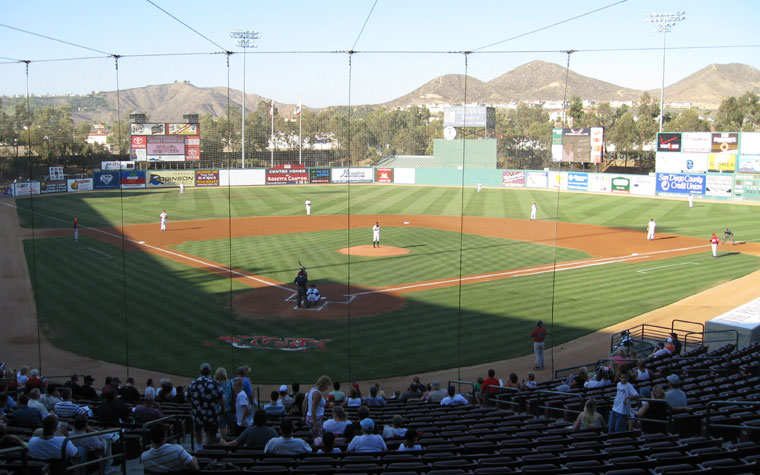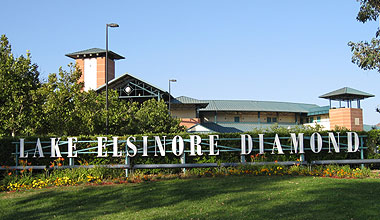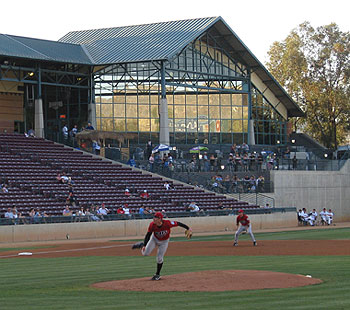
|
Professional baseball is played in a lot of cities you wouldn’t expect and Lake Elsinore is one of them.
A small lakeside town with a population of just 3,800 people in 1976, Lake Elsinore wasn’t exactly booming by the time the city's Redevelopment Agency built a stadium in 1994 at a cost of $22 million, so the decision to place a ballpark here in the first place was curious. Whatever the reason, the Diamond is an impressive ballpark by minor league standards, and especially by Class A ball standards. Built on the floodplain of the lake the city is named after, the Diamond is easy to find from nearby I-15. All you have to do is take the Diamond Drive exit until it literally dead ends at the entrance to the ballpark’s parking lot. There are a couple of parking lot attendants that greet you, but parking is free “if you don’t mind walking.” That’s what I was told by one of the attendants and it’s worth a chuckle, as the distance between the free and paid lots is only the four-lane street that splits the two lots in half. For the record, the large free lot is across the street from the Diamond while the small VIP paid lot surrounds the stadium’s exterior.
The Diamond has a single large concourse with a full view of the sunken playing field. The concourse is above the 6,066 fixed seats in the grandstand, which means you walk down to get to your seat. Tickets to sit in a grass berm down the right field line are only sold when the actual seats are sold out, but fans are free to roam the hill and watch the game from there anyway. There is no outfield seating, as everything is contained between the foul poles. The ballpark is situated so that all fans have a spectacular view of the mountains beyond the outfield fence, and the inside of the ballpark is as nice as the exterior. As evidenced by the price tag, Lake Elsinore went all out when they built their ballpark. That’s why you’ll find two video scoreboards in the outfield – a rarity at any level of the minors. The scoreboard in left center has current stats of the player hitting, the one in right center displays their picture, hometown and number…when not showing ads. A large glass paneled restaurant, the Diamond Club, is down the left field line. It has a Chili’s-type menu and a full service bar, both on par with what you’d expect in the big leagues. The triple-tiered Diamond Club Terrace offers outdoor seating below the restaurant, although the patio-style seats are hard to come by during games and not all tables have good vantage points of the playing field.
For evening games, the sun sets in the right fielder's line of vision and I saw Brian Giles, on a rehab assignment for San Diego, lose track of a fly ball. The setting sun may be a nuisance to players but no fans are affected since the sun sets behind the ballpark. As such, no roof is needed above the main grandstand and the seats are completely open to the elements. Only fans in the limited upper level suites are protected from infrequent rain. There is a green roof covering the concourse and foul balls rattle and roll off it during games, adding to the noise in a ballpark where the public address announcer is unusually loud, although entertaining The Storm have retired one number in their history, and Joe Urso’s # 7 rests above the hitter’s backdrop in center field. Urso was a fan favorite in Lake Elsinore and was the MVP of the 1996 team that won the franchise’s first California League championship. Urso’s number was retired in 1997 and he has since gone on to be a successful manager at his alma mater, the University of Tampa. The Storm are much better known for their logo than the pair of Cal League championships they’ve won. The Storm’s logo - a pair of sinister looking eyes on a solid colored background - is the top seller in all of Minor League Baseball for the New Era Cap Company. The logo is well promoted within the ballpark and even visible behind the benches of both Major League-style dugouts. What gets much less promotion is the financial losses the city has suffered because of the ballpark. Debt on construction has swelled to about $38 million, and at one point the city was using money that was supposed to be set aside for low and moderate income housing to pay the bills. Lake Elsinore spends almost $2 million a year paying off stadium debt, and will continue doing so until the construction bonds are finally paid off in 2030. As if the cost of construction wasn’t bad enough, the city also found itself spending $800,000 a year operating and maintaining the facility. To stop the financial bleeding, Lake Elsinore put its stadium up for sale a couple of times - hoping to fetch around $7 million - without any success. The city was finally able to relieve some of its financial burden when they came to an agreement with the Storm that gave the team full operational control of the stadium. The 10-year deal began on July 1, 2007 and included the city making financial concessions to the team, such as setting aside $300,000 a year for the duration of the agreement so capital improvements can be made to the Diamond. The drain on the city’s financial resources is similar to what’s happened to the city’s namesake lake over the years. Once a natural body of water, Lake Elsinore went dry in the 1930s. It was refilled in the early 1960s and since then there has been a continuous effort to keep it filled. The ballpark itself will need to be filled with plenty of fans and events other than baseball over the next decade to finally make it a financial success. That may not be easy in a city that didn’t get its first brand name hotel until 2006. But Lake Elsinore has been rapidly growing since the turn of this century, when the population was still only 28,928, and developing an entertainment district on the barren land that surrounds the ballpark is high on the city’s wish list. Although the city may be a diamond in the rough, their lake and mountainside ballpark is a wonderful finished project. But just like the cost of harvesting real diamonds, this Diamond has extracted a heavy toll. That toll has ultimately been borne by the citizens of Lake Elsinore, who have paid a heavy price to have one of the best ballparks in the low-level minor leagues.

Lake Elsinore Ballpark, City & Team Footnotes - Facts & Figures
| |||||||||||||||||||||||||||


 The Diamond makes a great first impression, as its visually pleasing exterior is well manicured. A freestanding sign with the ballpark’s name and a brick clock tower are nice touches, while a tree-lined walkway leads fans to the ballpark’s main gate behind home plate, where stacks of the team’s free (and up-to-date) program, Play Ball, await upon entrance.
The Diamond makes a great first impression, as its visually pleasing exterior is well manicured. A freestanding sign with the ballpark’s name and a brick clock tower are nice touches, while a tree-lined walkway leads fans to the ballpark’s main gate behind home plate, where stacks of the team’s free (and up-to-date) program, Play Ball, await upon entrance.
 Although it’s mostly covered with ads, the Diamond has its own version of the Green Monster in right field, complete with a hand-operated scoreboard run by a person wearing a pink rabbit suit and black sunglasses. The rabbit has an official name, Jackpot, but he’s also known as the RBI rabbit, an appropriate nickname for a mascot who comes out of a door in right field and briefly dances on the warning track every time the Storm score a run. You won’t see that anywhere else! Ditto for the vendors walking through the stands selling frozen bananas.
Although it’s mostly covered with ads, the Diamond has its own version of the Green Monster in right field, complete with a hand-operated scoreboard run by a person wearing a pink rabbit suit and black sunglasses. The rabbit has an official name, Jackpot, but he’s also known as the RBI rabbit, an appropriate nickname for a mascot who comes out of a door in right field and briefly dances on the warning track every time the Storm score a run. You won’t see that anywhere else! Ditto for the vendors walking through the stands selling frozen bananas.
